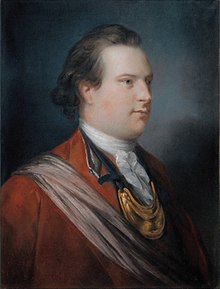George Keppel, 3rd Earl of Albemarle
This article includes a improve this article by introducing more precise citations. (May 2022) ) |
PC | |
|---|---|
 George Keppel, 3rd Earl of Albemarle, Francis Cotes | |
| Born | 8 April 1724 London, England, Great Britain |
| Died | 13 October 1772 (aged 48) London, England, Great Britain |
| Allegiance | |
| Service/ | |
| Years of service | 1745-1762 |
| Rank | Colonel General |
| Commands held | 3rd (The King's Own) Regiment of Dragoons |
| Battles/wars | |
| Spouse(s) | Anne Miller |
George Keppel, 3rd Earl of Albemarle
Early life
He came from a wealthy and powerful
Military career

George Keppel had been previously in his military life commissioned an ensign in the Coldstream Guards in 1738, becoming a captain-lieutenant of the 1st Regiment of Dragoons in 1741, aged 17, and a captain-lieutenant of the Coldstreams on 7 April 1743. Appointed aide-de-camp to the Duke of Cumberland in February 1745, was promoted to captain and lieutenant-colonel on 27 May 1745. The next year, he was promoted colonel and made aide-de-camp to the King on 24 April 1746. He had fought at the Battle of Culloden with his father and carried the dispatch of Cumberland's success to London.
Bury, later 3rd Earl of Albemarle, was returned as Member of Parliament for
On 8 April 1755, he became colonel of the
The outbreak of the
Later life

Keppel was made a
Politically, he was a prominent member of the
Legacy
Albemarle Street in Halifax, Nova Scotia is named after him.
See also
- Great Britain in the Seven Years War
References
- Doyle, James William Edmund (1885). The Official Baronage of England. London: Longmans, Green. p. 35. Retrieved 14 June 2008.
